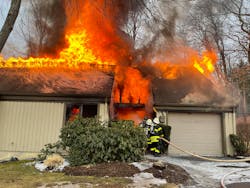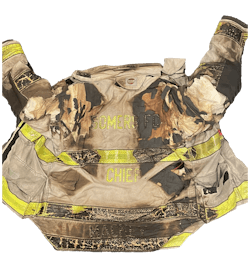Close Calls: Heavy Fire with Occupants Reported Trapped
There has been much talk for years of “go/no-go” as well as “survivability profile,” and rightfully so. There are occasions when, regardless, we can’t get into a building to save a victim, and there are occasions when we absolutely can get inside, do a search, control the conditions and get the victims out.
Then there are those occasions when the decision is a toss-up. That’s when the experience and training come into play, when conditions, resources and related size-up factors come into immediate play. At that moment, every fire that you went to, every training that you attended—“everything that you’ve got”—gets applied to your immediate decision-making.
That was the situation for Chief Jonathan Mackey of the Somers, NY, Volunteer Fire Department (SVFD) on Feb. 16, 2022, at a fire in the neighborhood where he lives. He arrived in seconds, with reports of people trapped and heavy fire and smoke conditions.
Our sincere appreciation to Mackey and all of the members of the SVFD who operated on scene. In addition, firefighters responded from Bedford Hills, Buchanan, Carmel, Croton Falls, Katonah, Mohegan Lake, Mount Kisco, Putnam Valley, South Salem and Yorktown Heights. A special thanks to the Westchester County “60-Control” fire dispatchers, to the ambulance and EMS crews from Lewisboro, Mahopac Falls, North Salem and Westchester County, and to the Westchester County Department of Emergency Services.
Account from Mackey
On Wed., Feb. 16, 2022, the SVFD operated at a structure fire in the Heritage Hills section of Somers. As chief of department, I arrived about a minute after dispatch, with heavy smoke and fire showing from the windows on the D side and above the front door on the A side. I transmitted a working fire assignment, bringing additional resources to the scene. Multiple bystanders were on scene.
On arrival, I was met by a private security guard for the complex (Justin Morelli, who is a member of the nearby Mahopac Fire Department), who received reports from bystanders of two people trapped. I transmitted a second alarm and relayed to my responding assistant chief (Greg Lucia) that I was passing command and beginning a search for victims.
After my size-up, I determined that the only possible tenable space for victims was in the bedrooms to the left of the front door, and I began an immediate search.
The building contained two residential units. I wasn’t sure which unit contained the windows on the A side that had smoke coming out of them.
With heavy fire showing on the C/D corner, Morelli and I went to the unit on the left. I forced the door with a Halligan. There was zero sign of fire. There wasn’t any furniture, so I processed that the chance of victims being in that unit was unlikely.Attempted rescue
I moved on to the unit on the right, where the bulk of the fire was. Heavy fire showed from the C/D corner and from the soffit that was above the front door.
My first action was forcing and entering through the front door to get to the bedrooms off of the hallway to the left (A/B corner), farthest away from the fire. Fire was coming from the top of the front door, but visibility was clear down low.
I entered and moved approximately seven feet to the hallway, with fire rolling overhead. I was on my knees, and I could see the whole floor of the living room and kitchen area and that there were no victims. I began moving to make the turn to go down the hallway toward the bedrooms.
Suddenly, the neutral plane dropped, and I instantly felt extreme heat. I still could see throughout the room; it was fire from ceiling to floor, a bright orange glow throughout, and it appeared that everything was burning. I presume that was a flashover.
With the extreme heat building, I instinctively turned my body to shield myself and covered my facepiece with my hands and began to retreat to the front door. This was a matter of mere seconds. There wasn’t time to think, just react, and that reaction, based on experience and training, most likely saved my life.
According to witness reports, I was inside of the building approximately 30 seconds and appeared to “be on fire” with “charred” bunker gear when exiting.
I immediately went to the windows on the A side of the building. I attempted to enter through the two bedroom windows to do VES.
I broke the window of the bedroom that was closest to the front door with my Halligan and was met with high heat and heavy smoke. I entered the window and searched as best that I could. With nothing visible or felt near the window, I moved on to the second window, which was the one of the farthest away from the front door. I broke the window and was met with the same conditions as I confronted at the first window. I was unable to enter into this window due to conditions but conducted a visual search from the windowsill with half of my body inside of the window.
With VES not an option, I made my way to the C side to find an alternate entry point to continue to try to get to the victims.
The fire had progressed rapidly. The rear was a wall of fire, with no way to get in. I moved back to the front.
My adrenaline was through the roof, and I started to feel the effects mentally, but physically it kept me going.
I started to make my way back to the A side of the building. I was severely fatigued and losing motor skills. I tripped and fell and sprawled out on the ground. Out of the corner of my eye through my facepiece, I saw my right arm and my charred and smoking coat. I was able to get up and continue to the front of the building.
By now, heavy fire was coming from the front door. I went to the farthest window on the A side and attempted to VES through the window again. Because of the height of the window and my exhaustion, I was unable to get my body through the window.
SVFD Ladder 48 arrived, and a handline was stretched to the front door in an attempt to darken down the fire to allow re-entry. I was on the nozzle and was backed up by SVFD Lieutenant Dylan Mechanic, Westchester County DES Battalion 13 Jason Blauvelt and Bedford Hills Fire Department Ex-Chief Jason Nickson.
The interior of the building was completely in free burn, and the 2-inch handline wasn’t making progress.
I turned the nozzle over to Mechanic and walked to the street to Lucia to give him a report and to get an update on command operations. With the arrival of apparatus and staffing, I knew that I had to shift gears into command mode again.
Through face-to-face communication, I assumed command from Lucia and assigned him to the operations role.
Shortly thereafter, additional SVFD units arrived, followed by mutual-aid companies.
After stretching multiple handlines, crews were unable to make progress to allow searches to continue, and units switched to a defensive operation with the aerial stream from Ladder 48 to protect the connecting exposure.
A reality check
I have been in the fire service for 17 years as a firefighter, officer, chief officer and instructor on the career and volunteer sides. I believe in the education that experience brings. Every fire can be a learning experience. I have had many great fire instructors and teachers who imparted their knowledge and experience onto me.
I wore my full PPE, and it did its job. Everything from my helmet down to my boots was destroyed, including my SCBA. Without my hood, gloves, etc., the outcome would have been worse. This diligence comes from practice. When you’re under intense stress, muscle memory takes over.
We preach recognizing the early signs of flashover.One thing that I realized after: Covering my facepiece with my gloved hands and turning to protect my body and critical areas was essential to protecting myself from thermal damage. To tell you the truth, most of the first few minutes were a blur, and I wasn’t thinking, just doing. My training kicked in.
Unfortunately, the sole resident didn’t make it, but I know everything physically possible was done to try to rescue the individual. The victim was found deceased in the area of the second window, removed from the front door, approximately three feet from the windowsill. A dog was found during salvage efforts.
I have replayed this incident in my head over and over, and by no means am I saying that it went perfectly. Under those conditions, perfect was impossible. Arriving first at a working fire, operating alone and having to make that go/no-go decision is one of the most difficult choices that an officer or firefighter must make. To make it even more challenging, you have seconds to decide.
As a chief officer, that decision is even more complex, because your first instinct is to assume a command role, but sometimes when the situation dictates it, you must remember your priorities and act. There is a very fine line between bravery and stupidity, but sometimes we must push those limits to save a life.
In the real world, we are tasked with making life-or-death decisions on a regular basis, and those decisions have serious consequences.Comments from Goldfeder
At some point, everyone who reads this column will have a “Super Bowl” fire, the fire or incident where everything that you have done urgently comes into play—every class, training, conference, seminar, article, report. This was Mackey’s “Super Bowl” fire, and he gave it his all.
What if he wasn’t into the job? What if he ignored classes, skipped training, waved off the “it’s too far away” conference, didn’t read another article or NIOSH report?
The fact is that our learning and training never stops. On duty. Off duty. Paid for or pay it yourself. Wherever and whatever you can. Load yourself up with every opportunity, because one day, you will arrive first-due.
Mackey had what by all accounts was a victim to save. The individual might have been by a door, by a window or in a closet. He didn’t know, but his training helped him to identify where the person might be surviving. He understood modern fire behavior and applied that as he searched. He brought years of active training, education and experience to that fire. Unfortunately, the victim couldn’t be reached, but that wasn’t for his lack of training, experience and selfless attempts.
The Somers Volunteer Fire Department
The Somers, NY, Volunteer Fire Department provides fire protection, emergency medical care, vehicle extrication, underwater rescue, hazmat response and pump-outs, among other services, to its community. The department protects more than 20,000 citizens in a 33.3-square-mile response district. It’s staffed with more than 90 active volunteer members and responds to an average of 800 fire and 2,000 emergency medical runs annually.
About the Author
Billy Goldfeder
BILLY GOLDFEDER, EFO, who is a Firehouse contributing editor, has been a firefighter since 1973 and a chief officer since 1982. He is deputy fire chief of the Loveland-Symmes Fire Department in Ohio, which is an ISO Class 1, CPSE and CAAS-accredited department. Goldfeder has served on numerous NFPA and International Association of Fire Chiefs (IAFC) committees. He is on the board of directors of the IAFC Safety, Health and Survival Section and the National Fallen Firefighters Foundation.




